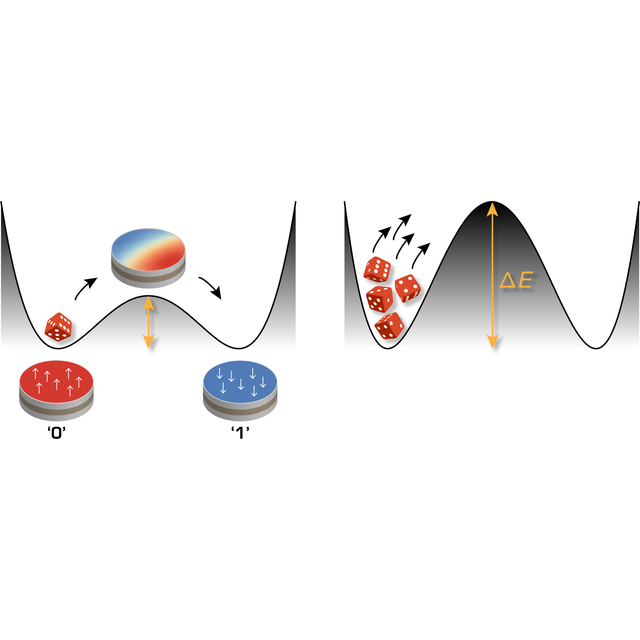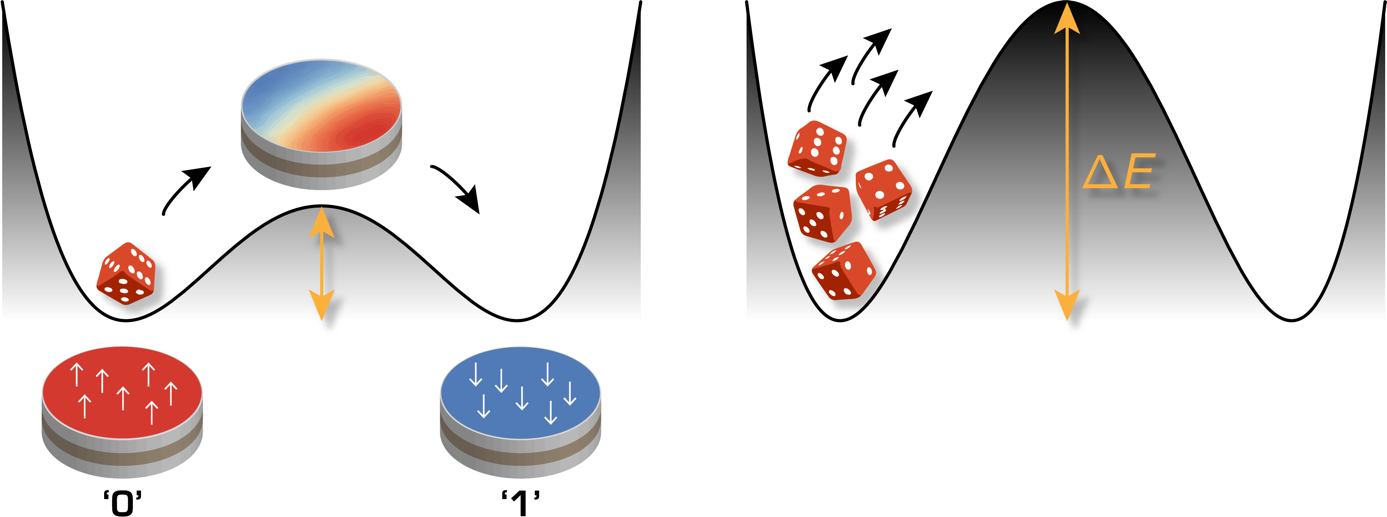Retaining stored information in magnetic materials relies on making energy barriers difficult to overcome. In a theoretical study, two researchers at C2N show that the resulting entropy can have the opposite effect. Their results challenge some common assumptions about thermal stability in magnetic nanostructures.
Digital information is stored in magnetic memories as “up” or “down” states of magnetic moments, and predicting accurately the lifetime of such states is a difficult problem with strong practical implications. Estimates of this retention time are often based solely on the activation barrier, which represents the minimum energy needed to switch the moments from one state to the other. It is generally accepted that the higher the barrier, the less likely thermal fluctuations will cause a magnetic bit to flip erroneously from one state to the other. But the number of different ways to achieve this switching can become equally important in certain nanoscale magnets. The heart of the issue lies in the so-called Arrhenius law. It states that the rate of escape from an “up” or “down” configuration due to thermal fluctuations depends exponentially on the activation barrier and linearly on a quantity called the “attempt frequency”. As a rule of thumb a frequency in the GHz range, which characterizes the damped resonant dynamics of the magnetic moments, is generally assumed.
In a work published in Physical Review Letters in September 2020, two researchers at C2N show theoretically that another contribution to this attempt frequency due to entropic effects can become equally important. The study focuses on thermal activation involving nonuniform magnetic states such as a domain wall, which represents the boundary between regions of “up” and “down” moments. Here, entropy expresses the many different ways in which fluctuations can combine with the domain wall to achieve switching. This switching mode is expected in nanometre-thick disks used in magnetoresistive random access memories.
Crucially, they find that the entropic component of the attempt frequency increases exponentially with the activation barrier, which then partially negates the stability afforded by a high barrier in the first place. While this phenomenon, known as entropy-enthalpy compensation or “Meyer-Neldel rule”, has been observed for nearly a century across different fields of the natural sciences, it remains relatively rare in magnetism, but perhaps only because it has been overlooked.
The study suggests that compensation might be more prevalent than previously thought, which may encourage other researchers to revisit the issue of thermal stability in magnetic systems and spintronic devices.
Figure: Schematic illustration of thermally-activated magnetization reversal in a memory element between “up” (‘0’) and “down” (‘1’) states via a domain wall. As the energy barrier ΔE increases, the entropic contribution to the attempt frequency increases due to the exponentially larger number of ways thermal fluctuations can combine with the domain wall to achieve reversal.
increases, the entropic contribution to the attempt frequency increases due to the exponentially larger number of ways thermal fluctuations can combine with the domain wall to achieve reversal.
References:
Entropy-reduced retention times in magnetic memory elements: A case of the Meyer-Neldel compensation rule
Louise Desplat1,2 and Joo-Von Kim1
Physical Review Letters 125, 107201 (2020)
DOI: 10.1103/PhysRevLett.125.107201
Link to arXiv preprint: arXiv:2007.02152
1. Centre de Nanosciences et de Nanotechnologies (C2N), CNRS / Université Paris-Saclay
2. Institut de Physique et Chimie des Matériaux de Strasbourg (IPCMS), CNRS / Université de Strasbourg










